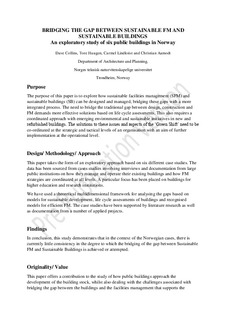Bridging the gap between sustainable FM and sustainable buildings an exploratory study of six public buildings in Norway
Journal article, Peer reviewed
Accepted version
Permanent lenke
http://hdl.handle.net/11250/2626775Utgivelsesdato
2019Metadata
Vis full innførselSamlinger
Originalversjon
10.1108/F-01-2018-0007Sammendrag
Purpose
The purpose of this paper is to explore how sustainable facilities management (SFM) and sustainable buildings (SB) can be designed and managed, bridging these gaps with a more integrated process. The need to bridge the traditional gap between design, construction and FM demands more effective solutions based on life cycle assessments. This also requires a coordinated approach with emerging environmental and sustainable initiatives in new and refurbished buildings. The solutions to these issues and aspects of the “Green Shift” need to be co-ordinated at the strategic and tactical levels of an organisation with an aim of further implementation at the operational level.
Design/methodology/approach
This paper takes the form of an exploratory approach based on six different case studies. The data have been sourced from cases studies involving interviews and documentation from large public institutions on how they manage and operate their existing buildings and how FM strategies are coordinated at all levels. A particular focus has been placed on buildings for higher education and research institutions. The authors have used a theoretical multidimensional framework for analysing the gaps based on models for sustainable development, life cycle assessments of buildings and recognised models for efficient FM. The case studies have been supported by literature research and documentation from a number of applied projects.
Findings
In conclusion, this study demonstrates that in the context of the Norwegian cases, there is currently little consistency in the degree to which the bridging of the gap between sustainable FM and SB is achieved or attempted.
Originality/value
This paper offers a contribution to the study of how public buildings approach the development of the building stock, whilst also dealing with the challenges associated with bridging the gap between the buildings and the FM that supports the building. The introduction and use of a multidimensional theoretical framework for analysing sustainability in buildings and FM creates a new platform for further research, development and implementation in practice.
